Key Takeaways:
Digital lending is projected to reach nearly $890 billion by 2030, making it a lucrative opportunity for entrepreneurs.
Automating loan lending processes with AI reduces operational costs, minimizes human error, and speeds up credit approvals.
Transparent loan approvals and clear repayment terms build trust with borrowers, lenders, and regulators.
To develop an app like Upstart, start by conducting market research, defining your app idea, planning app design, selecting a tech stack, coding, and post-launch scaling.
Core features like AI credit scoring, digital KYC, fraud detection, and personalized dashboards improve user experience and reduce defaults.
Testing with functional, security, and load checks guarantees smooth performance during high traffic and peak usage.
Upstart-like app monetization strategies include referral fees, platform fees, servicing, licensing, and interest income.
The key development challenges include biased AI models, data security, compliance costs, and scaling.
The increasing financial literacy has trained individuals to keep a better track of their finances and investments. But even individuals with good finances require credit at some point in time.
Such requirements have contributed to the rise of digital lending, which is projected to grow at a CAGR of 27.7% from 2025 to 2030. Such a growth in itself is sufficient to reflect the potential business opportunity that modern-day entrepreneurs can focus on for their next business venture.
Focusing on such growth potential, several new-age platforms such as LendingClub, Dave, and Upstart are making efforts to transform the digital lending space.
To create an AI loan app like Upstart, start by focusing on the industry trends, defining your loan lending app idea, planning key features, its USPs, tech stack, monetization strategies, and partnering with an experienced app developer.
In this blog, we will help you with every question of yours regarding “How to develop a loan lending app like Upstart?”. From the current trends to the development process, app features, tech requirements, cost expectations, and more.
What is Upstart, and How Does it work?
Upstart is an AI-powered lending platform, founded in 2012 to enable effortless credit for Americans. The platform’s approach to blending AI with loan lending has helped Upstart gain popularity and scalability.
The platform partners with banks and credit unions to offer unsecured, fixed-rate personal loans. It uses artificial intelligence and machine learning to assess creditworthiness, moving beyond traditional credit scores to include factors like education, employment history, and income.
As of mid-2025, it had more than 3 million customers, with a total of $38 billion offered as loans. Upstart has a range of service offerings, from personal loans to auto refinance loans, debt consolidation loans, to inclusive lending, and more.
How Does it Work?
If you are interested in knowing “how to create a loan lending app like Upstart”, then you need to be aware of how the platform works.
Upstart works as a two-sided marketplace. It connects consumers seeking loans with banks and credit unions that use Upstart's technology to make more accurate and inclusive lending decisions.
► For Borrowers:
-
Sign Up and User Onboarding: The user downloads the app, signs up, and provides personal and financial information that is essential for user verification.
-
Soft Credit Check and User Verification: Once the user submits the details, Upstart verifies the information and conducts a soft credit check.
-
Loan Application: The user is notified of their successful verification, post then they can apply for the loan or the credit.
-
AI-Powered Approval: Using AI, the platform evaluates a user's credibility based on 1600 variables to reduce defaulters and to provide instant loan approvals.
-
Repayment Scheduling: The approved loan is transferred to the user’s bank account linked with the platform, and a repayment schedule is created. Further, the app also provides timely notifications and reminders to the users.
► For Banks and Credit Unions:
They act as lenders; hence, Upstart acts as a partner to them, offering them access to a vast customer base, customizable policies, and reduced risk opportunities.
Key Market Statistics
Upstart is significantly transforming the digital lending sector, and its success can be better justified through the following statistics.
-
In Q2 2025, Upstart originated USD 2.8 billion worth of loans across 372,599 transactions, reflecting a 28% year-over-year increase.
-
Upstart’s borrower funnel efficiency is improving sharply. Its conversion rate reached 23.9% in Q2 2025, up from 15.2% in Q2 2024.
-
Partner banks using Upstart’s AI can approve 101% more applicants while lowering APRs by 38% compared to traditional credit scoring systems.
Let’s focus on some key global lending sector statistics that can help you better understand why you should focus on the opportunities to “build an AI loan lending app like Upstart.”
-
The Global Digital Lending market is expected to reach USD 889.9 billion by 2030, at a CAGR of ~11.9%.
-
The Digital Lending Platform market is also on a steep growth curve, rising from USD 10.9 billion in 2024 to USD 114.7 billion by 2034 (CAGR ~26.5%).
-
The Global Auto Loan market is forecasted to grow at a CAGR of 8.3%, creating more scope for auto financing apps and services.
-
The BNPL segment continues its expansion, with forecasts suggesting 25.3% CAGR growth in the U.S. and 9% CAGR globally by 2028.
Benefits of Developing an AI Loan App Like Upstart
If you are looking for the reasons why you should develop an AI loan lending app like Upstart, then you should consider the following benefits:
1. Steadily Growing Market
The digital lending sector is expanding rapidly, with a projection that it will cross $889 billion by 2030. This is just an estimation, and as per the trends, these segments are growing even faster.
Hence, it offers new founders a chance to step into the market and make an AI loan lending app like Upstart that can offer the desired scalability.
2. Proven Business Model
If you plan to make an AI lending platform like Upstart, then you are already following a proven business model.
In 2025, Upstart’s revenue almost doubled compared to 2024, despite maintaining high profit margins of 61%. Hence, the business model is both proven and profitable.
3. Lower Operational Costs
The AI lending platform, like Upstart, relies on AI capabilities for tasks like checking credit, spotting fraud, or verifying documents. Hence, this reduces the need for large teams and cuts errors.
4. Build Trust Through Transparency
Borrowers and regulators both want to see fair and clear decisions. If your app explains why a loan was approved or denied, you win trust.
That trust helps you attract more users and makes your app more attractive to partners and investors.
5. Global Opportunity
There are limited players globally focused on AI in loan lending. Hence, with your dedicated efforts, you can plan to expand to global markets where the trend of rising demand for digital credit is growing.
Step-by-Step Development Process To Create An App Like Upstart
If you are interested in knowing about how to create an AI loan app like Upstart, then you should check out the step-by-step process below.
It’s a structured roadmap that covers market research, design, AI training, compliance, and scaling. Each stage defined ensures that the app is not only functional but also secure, compliant, and user-friendly.
Step 1: Market Research and Requirement Analysis
The initial focus should be on understanding the global and regional loan lending market trends. Such can help understand and point out what users and industry stakeholder expects.
These can be included when you proceed with your approach to develop an AI loan lending app like Upstart.
A] Understanding the Lending Market
Borrowers expect speed, clarity, and transparency in loan applications, while regulators demand compliance with strict lending laws.
Studying how to develop apps like SoFi, LendingClub, and Upstart helps identify market gaps your app can fill.
B] Gathering Requirements
Once you have completely evaluated the market, draft a business requirement document (BRD).
This outlines features, compliance needs, user journeys, and technical considerations. A strong requirement analysis serves as the foundation for the entire project.
Step 2: Defining Features
The next step is to define key features that you are planning to include in your app. The app features should distinguish you from competitors and attract the audience's attention.
A] Core Features
Start with the basic features borrowers expect today. Such includes instant loan applications, AI-powered credit scoring, repayment reminders, EMI calculators, and real-time notifications.
Features like digital KYC and fraud detection ensure smooth onboarding and risk control.
B] Expand Features With Scalability
After getting the desired app popularity, the next step is to expand the app features to support its scalability and growth.
Such expanded features can integrate blockchain, adding more financial products and other cross-platform integration options.
Step 3: UI/UX Design
Having an engaging and user-friendly app design is important to ensure your app's scalability and growth.
App UI/UX is also significant to ensure the proper integration of the app features, being aligned with the changing industry trends, and ensuring app scalability.
A] App Designing
The first step in design is building an app wireframe. This is a low-fidelity layout that shows where buttons, forms, and navigation elements will sit. Wireframes help align stakeholders on the basic structure before investing in visuals.
B] Create A Test App
Once wireframes are approved, designers move on to an app prototype. Prototypes are interactive and simulate how users will apply for loans, check eligibility, or track repayments. This stage is critical for spotting usability issues early.
C] Final Designing
After prototypes are tested, the mobile app design needs to be finalized with branding, typography, and colors. In financial apps, the UI/UX must inspire trust and make processes like loan applications or repayments simple and transparent.
Step 4: AI Model Development and Training
To develop an AI lending platform like Upstart, there is a need to focus on advanced AI models that can support the app's operations and contribute to its USP.
Look for experts who can ensure effective AI model development and training for your Upstart clone app development.
A] Collecting and Preparing Data
AI models rely on large datasets to predict creditworthiness. Since startups often lack sufficient data, partnerships with banks, credit bureaus, or third-party providers can help. Synthetic data can also be generated to fill early gaps.
B] Training the Model
The collected data is used to train AI/ML models to evaluate credit risk beyond traditional FICO scores. These models must be tested for fairness to ensure they don’t discriminate against borrowers.
C] Continuous Improvement
AI models should be dynamic. Each loan application and repayment adds new information, helping the system improve accuracy over time. Continuous retraining ensures better decision-making as the user base grows.
Step 5: Compliance and Security Integration
In the process to create an AI loan lending app like Upstart, focusing on the compliance requirements and security integrations is essential.
Such compliance is also important for your business scalability and user retention.
A] Compliance with Lending Laws
Financial apps must comply with the local and regional laws and regulations. Such as in the U.S., they must comply with laws such as the Truth in Lending Act and the Equal Credit Opportunity Act.
Consider partnering with a legal expert to ensure that compliance is built directly into the app architecture, avoiding costly rework and protecting against legal risks.
B] Security Frameworks
In your journey to develop an app like Upstart, data security is just as critical as the coding process.
Implementing multifactor authentication, encryption, tokenization, and zero-trust security strengthens your mobile app security.
Compliance with standards like SOC 2 and PCI DSS ensures that personal and financial information remains secure and improves borrower confidence.
Step 6: Choosing the Tech Stack
The chosen tech stack further plays an essential role in ensuring your app's scalability and in integrating AI and other advanced features.
When choosing a loan lending app tech stack, it is significant to focus on building a strong foundation that can support your app when it scales.
A] Backend Development
The backend handles business logic like loan application workflows, credit scoring integration, repayment schedules, and fraud detection.
APIs are developed to connect different modules and enable smooth operations.
B] Frontend Development
On the frontend, developers bring the app prototype to life. Borrowers see clean dashboards, application forms, and repayment trackers.
Along with all, the frontend must be intuitive and optimized for speed, as delays can harm user trust.
C] Scalable Architecture
Adopting a microservices-based architecture ensures the app can handle thousands of users. Cloud-native setups with Kubernetes or Docker add flexibility to scale on demand.
Step 7: Testing and Quality Assurance
Conducting mobile app testing is significantly important so that any errors or gaps in the app development can be identified and timely eliminated.
Such a testing approach is significant, as these errors can impact both the user’s experience and the app's scalability. Key tests that should be performed are as follows:
A] Functional Testing
Every feature is tested to ensure it works as planned. From loan applications to repayment notifications.
B] Security Testing
Security testing includes penetration testing and vulnerability scans that help identify weak points that hackers might exploit.
C] Load and Stress Testing
AI loan apps must perform under pressure. Load testing simulates high traffic to confirm the app won’t crash during peak usage.
Step 8: Deployment and Launch
Once all the relevant testing and improvements have been done, the final stage is to deploy or launch your app.
For the app launch, you can either plan to publish the app on the Play Store or submit the app to the App Store. It is recommended to have an app for both platforms for a better reach.
A] Cloud Deployment
Once tested, the app is deployed on cloud platforms like AWS or Google Cloud. Auto-scaling ensures the app adjusts resources based on traffic.
B] Platform Requirements
Check for every key requirement of the Play Store or App Store and fulfill it, as missing any condition can even result in the removal of your app from the platform.
Step 9: Post-Launch Support, Maintenance, and Scaling
Simply launching the app is not enough. But post-launch, there is a need to look for post-launch support, continuous mobile app maintenance, and upgrades.
These practices are significantly important so that new features can be introduced, existing gaps can be eliminated, and users’ experience can be enhanced.
A] Continuous Updates
After launch, apps require regular updates for bug fixes, UI improvements, and compliance changes.
B] Scaling with Growth
As more borrowers join, scalability becomes crucial. Tools like Docker and Kubernetes make it possible to serve thousands of users without downtime.
C] Analytics and Feedback
Post-launch analytics track borrower behavior, repayment rates, and churn. These insights help refine both AI models and user experience.
Features to Have in an App Like Upstart
So now you know the key steps to be focused on in the process of how to develop an AI loan lending app like Upstart.
But before you proceed with the development process, prepare a detailed loan lending app features checklist, including features to have in your Upstart clone app development.
1. AI-Powered Credit Scoring
Go beyond credit scores. Use AI to study income, spending, job history, and other data. This makes the lending fairer and opens the door for more people to get approved.
2. Instant Loan Application
A guided form that is short and simple. Users should be able to apply for a loan in minutes without long paperwork.
3. Push Notifications and Reminders
Alerts for due dates, new offers, or missed payments. Reminders cut down on defaults and improve the overall loan recovery rate.
4. Fraud Detection System
AI can spot strange patterns like repeated failed logins, mismatched documents, or unusual transactions. This protects both the platform and lenders.
5. Data Security and Encryption
Strong security is a must. End-to-end encryption and secure cloud storage protect user info and keep the app compliant with rules.
6. Easy Sign-Up and Profile Creation
Let users join with phone, email, or social accounts. A clean profile makes it simple to store basic details, income info, and loan preferences.
7. Personalized Dashboards
Another key feature to include when planning to develop an AI loan lending app like Upstart is having a personalized dashboard for both lenders and borrowers.
8. KYC and Identity Verification
Add secure ID checks like document scan, face match, or bank account linking. This keeps the platform safe from fraud and builds trust with lenders.
Tech Stack Required For Upstart-like App Development
The approach to build an AI loan app like Upstart is not just about design and user flow. The real backbone is the app tech stack that powers features like instant scoring, fraud checks, and payments.
Here’s how the stack breaks down by the core functions your app will need.
|
Function |
What it does |
Tools and services |
|
User onboarding |
Sign up, login, profile, consent |
React Native or Flutter for mobile. Next.js for web. Auth0 or Cognito. Feature flags with LaunchDarkly |
|
KYC and bank link |
ID checks and income proof |
Onfido or Trulioo for IDV. Stripe Identity. Plaid or Finicity for bank data. OCR for docs |
|
Data intake and features |
Collect raw data and create features for models |
Kafka for events. PostgreSQL for core data. Redis for speed. Feast as a feature store |
|
AI credit scoring |
Score risk and set loan terms |
Python. PyTorch or TensorFlow. FastAPI for model APIs. SHAP or LIME for reasons |
|
Automated underwriting |
Approve or decline in real time |
A rule engine like Open Policy Agent. Workflow with Temporal or Camunda. Rate limits with Kong or NGINX |
|
Offer and pricing |
Build offers with APR, term, and amount |
Pricing service in Node.js or Spring Boot. Config in PostgreSQL. A/B tests with Optimizely |
|
Payments and disbursement |
Payout loans and collect EMIs |
ACH and RTP via Stripe or Modern Treasury. Card rails via Stripe or Adyen. Webhooks for status |
|
Collections and reminders |
Reduce missed payments and NPA |
Notification service with Firebase or OneSignal. Email with SES. Dialer or SMS via Twilio |
|
Fraud and risk monitoring |
Catch fake users and bad behavior |
Device checks with ThreatMetrix or SEON. Velocity rules in Redis. Graph checks with Neo4j |
|
Analytics and reporting |
Track funnels, cohorts, risk, revenue |
Snowflake or BigQuery. dbt for transforms. Looker or Metabase for dashboards |
|
Admin and lender portal |
Control panel for ops teams and partners |
React or Next.js. RBAC with Keycloak. Audit trails with ELK or Loki |
|
Security and compliance |
Protect data and prove controls |
TLS. AES-256 at rest. KMS on AWS or GCP. Vault for secrets. IAM and detailed logs |
|
DevOps and scale |
Ship fast and stay reliable |
AWS or GCP. Docker. Kubernetes. GitHub Actions. Monitoring with Prometheus and Grafana |
Upstart Like App Development Cost and Timeline
Every entrepreneur has a question: “How much does it cost to build an app like Upstart?”
The average cost to develop an AI loan lending app like Upstart can range from $20,000 to $250,000 or even more, depending on various factors.
Understanding these factors impacting the mobile app development cost can help you better plan your app differentiation and your budget.
|
Phase |
Activities / Deliverables |
Time Estimate |
Cost Estimate* |
|
Discovery & planning |
Market research, requirements, compliance mapping, feature list |
3 – 6 weeks |
$10,000 – $25,000 |
|
Design & prototyping |
UI/UX, wireframes, clickable flows, design systems |
4 – 8 weeks |
$15,000 – $35,000 |
|
Core development |
APIs, backend logic, mobile, and web app modules |
3 – 6 months |
$50,000 – $150,000+ |
|
AI & credit modeling |
Data ingestion, model building, validation, and explainability |
1 – 3 months (parallel) |
$20,000 – $100,000+ |
|
Integrations & third parties |
KYC/ID, banking, credit bureaus, payment gateways |
2 – 4 weeks (or more, depending on complexity) |
$10,000 – $40,000 |
|
Testing / QA / Security audits |
Functional, performance, security, and compliance tests |
4 – 8 weeks |
$10,000 – $30,000 |
|
Deployment & launch |
App store submission, server setup, and go live |
2 – 4 weeks |
$5,000 – $15,000 |
|
Post-launch support/maintenance |
Bug fixes, updates, system upgrades, scaling |
Ongoing |
Typically, 15%–25% of the initial build cost per year |
Factors Affecting the Cost to Develop an AI App Like Upstart
The key factors impacting the cost to develop an AI app like Upstart include:
1. Scope of Features
A basic app with loan applications, AI scoring, and KYC can be in your budget. However, adding fraud detection, multi-loan categories, dashboards, and advanced analytics raises both time and cost.
2. AI Complexity
Training and deploying machine learning models when planning to develop an AI loan lending app like Upstart is resource-heavy.
A simple rule-based model costs less, while explainable AI with alternative data and real-time scoring can add 20–40% to the total estimation.
3. Design and User Experience
A simple interface takes less time and also ensures a controlled cost to develop a loan lending app.
Custom animations, sleek dashboards, and multiple user roles (borrower, lender, admin) increase design hours and cost.
4. Integrations with Third-Party Services
Linking to banks, payment gateways, KYC providers, and credit bureaus involves licensing fees and extra development. Hence, each additional integration means higher costs.
5. Security and Compliance
Loan lending apps must follow strict laws like GDPR or U.S. lending regulations. Hence, building audit trails, encryption layers, and regulatory reporting modules adds extra expense.
6. Development Team Location
The mobile app development company in Denver or Western Europe charges $100–$200 per hour. Teams in Eastern Europe or Asia often cost $40–$80 per hour, changing the total budget significantly.
7. Scalability Requirements
If you need to handle millions of users from day one, the app must be cloud-ready with microservices and auto-scaling. That setup costs more than a smaller MVP.
8. Post-Launch Support and Maintenance
Ongoing costs for bug fixes, server hosting, AI model updates, and new features typically add 15–25% of the initial cost each year.
Challenges in Developing an AI Loan App Like Upstart
Let’s proceed with discussing key challenges in loan lending app development that you must be aware of as an entrepreneur, before you proceed to develop an AI loan lending app like Upstart.
Such an awareness can help you plan for key actions from the initial app development process.
Challenge 1: Training AI Models
To build an AI loan lending app like Upstart, your app needs to have smart credit models. However, to make them work, you need a lot of quality data about how people borrow and repay.
Solution: Such a challenge can be eliminated by partnering with an experienced AI app development company. They can help with such AI training and upgrade needs.
Challenge 2: Ensuring Fairness and Ethical Nature
AI can sometimes make unfair choices if the data has hidden bias. For example, it might favor one group of borrowers over another. Also, it may misinterpret any legal terminology, resulting in making false decisions regarding loan approvals.
Solution: Running regular bias audits, using explainable AI frameworks, and keeping human oversight can help maintain fairness and transparency in decisions.
Challenge 3: Following Lending Rules and Compliance
The loan-lending sector has strict laws on business operations, data use, and customer rights. If your app misses any of these rules, it could face hefty fines or even a ban.
Building such compliance into the app takes time and money, resulting in it being a key challenge or threat to create an AI lending platform like Upstart.
Solution: Integrate compliance checks from the app inception and consult legal experts to ensure your app adapts to U.S. lending laws.
Challenge 4: Protecting User Data
People share personal and financial details when they apply for loans. Any security slip could break trust.
Solution: Strong encryption, safe servers, and regular checks are all needed to protect users. Hence, not only implementation but also its maintenance is a key threat in the Upstart clone app development process.
Challenge 5: Managing Costs
The implementation of AI systems, fraud checks, and security tools is not cheap. Beyond the cost to build an AI loan lending app like Upstart, you also need to pay for servers, updates, and app maintenance.
For many startups, the cost to develop an AI app can surpass their budget and feel heavy.
Solution: Use cloud-based AI services and prioritize MVP features to control upfront costs, scaling infrastructure as your user base grows.
Challenge 6: Earning User Trust
Many borrowers still look at traditional banks for their credit needs. Hence, convincing them is a key challenge.
Hence, your app must explain loan terms clearly, make decisions fast, and provide good support.
Solution: Keep loan terms clear, provide instant eligibility checks, and add responsive support to make users feel confident in your platform.
Challenge 7: Scaling as You Grow
An app that works fine for a few hundred users may slow down when thousands join. Without the right planning, you could face delays, errors, or crashes as the platform grows.
Solution: Adopt microservices and cloud auto-scaling to handle growing traffic smoothly, while monitoring performance to prevent downtime.
How an AI Loan App Like Upstart Makes Money?
Simply focusing on “How to develop a loan lending app like Upstart?”, you also need to focus on Upstart-like app monetization strategies.
Planning on such mobile app monetization strategies can help plan your development process since the beginning, and accordingly, relevant feature integrations and improvements can be made from the start.
Such monetization strategies include:
1. Referral Fees
An AI loan app like Upstart connects borrowers with banks and institutions. Hence, when a borrower’s loan request is approved, the lending partner pays Upstart a fee.
Such is often a percentage of the complete loan value, and is a major chunk of revenue if you are planning to build an AI lending platform like Upstart.
2. Platform Fees
The users pay a fixed fee for using the Upstart platform. The financial institution pays a fee for the privilege of using Upstart’s AI-driven platform for its customers.
On the other hand, the users pay the platform fee in the form of a subscription fee or other charges for using the platform.
3. Servicing Fees
The AI loan app like Upstart, continues to earn by managing repayments, collecting EMI, and handling customer support on behalf of lending partners.
Hence, such servicing fees act as a recurring revenue for the platform.
4. Licensing Fees
Upstart also earns revenue by licensing its technology as a software service to other financial institutions.
Hence, you can plan for such a proprietary technology that can be licensed in exchange for fees.
5. Interest Income
Along with connecting the borrowers and financial institutions, the app also funds a certain percentage of loans. Hence, the interest charged on those loans is also part of the monetization strategy of Upstart.
How JPLoft Can Help You Develop an App like Upstart?
Developing an AI loan lending app like Upstart requires much more than just coding expertise. A loan lending app needs to be aligned with industry trends, compliance, and user expectations.
Partnering with JPLoft, the experienced loan lending app development company, can help you build loan lending apps that are not just smart but also secure and scalable.
Our team has expertise in developing custom AI models for accurate credit scoring, ensuring compliance with regional lending regulations. Also, integrating strong security measures like encryption and multifactor authentication to protect sensitive data.
With us, you can get a scalable architecture so that your app performs seamlessly as your user base grows. Also, we offer complete maintenance and support from MVP development to launch and ongoing maintenance.
Hence, with JPLoft, you don’t just get an app, but a partner committed to turning your loan lending app vision into reality.
Conclusion
The current market trends reflect the opportunity to build an AI loan lending app like Upstart and be part of this transforming market.
If you are still wondering how to develop a loan lending app like Upstart, then start by conducting market research to understand what other players are offering. Accordingly, define your business app idea, prepare a feature checklist, pick a tech stack, and partner with experienced developers.
Further, focusing on innovative features like AI credit scoring, strict compliance, and a user-friendly experience will help ensure the app's success and scalability.
If you are serious about entering this space, having a trusted partner like JPLoft by your side can save you time, reduce risk, and ensure your app is secure and scalable. Let’s build the next popular name in the global loan lending sector.
FAQs
The Upstart loan lending app development process starts with defining your app idea, planning app UI/UX, picking a suitable tech stack, conducting app testing, making improvements, and publishing it on the app store or the Play Store.
The cost to develop an AI loan lending app like Upstart can range from $20,000 to $250,000 or even more, depending on several factors. These include the app features, AI complexity, development team location, and much more.
Developing an app like Upstart faces challenges due to AI complexity, accuracy in decisions made by AI tools, aligning with industry compliance, ensuring data protection, and retaining users’ trust. Also, managing the development cost and budget is a key challenge to focus on.
The app makes money through multiple routes, including referral fees, platform fees, servicing fees, earnings through interests, and licensing fees.
The average timeline required to build an AI loan lending app like Upstart can be anywhere from 12 to 18 months or more. Such depends on the expertise of the development team, the feature complexity, the time involved in testing, and fulfilling compliance requirements.





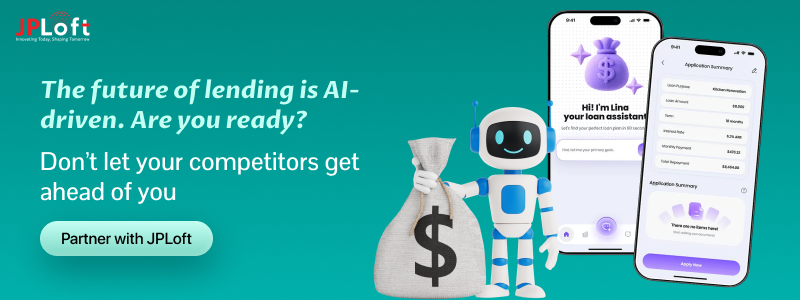
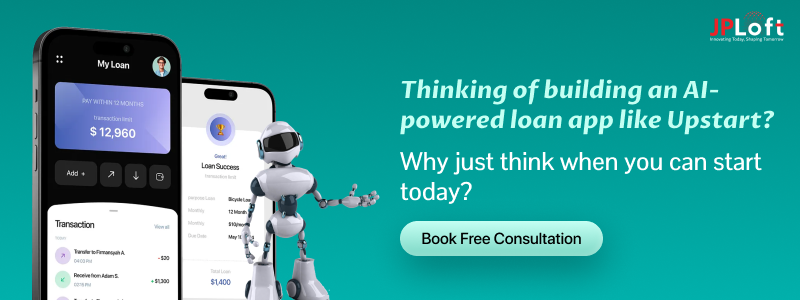

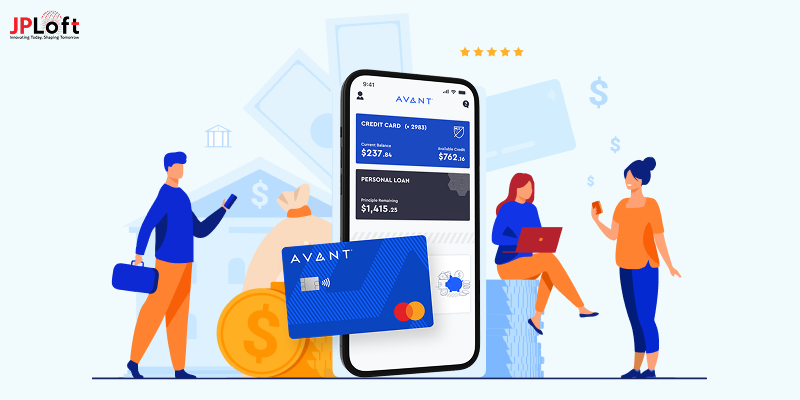
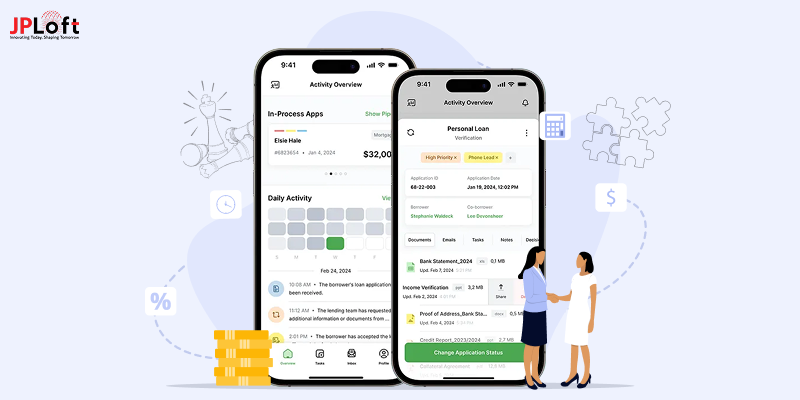
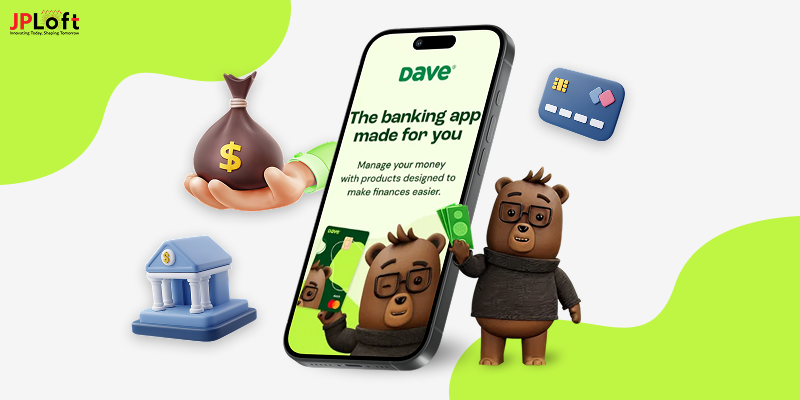


Share this blog